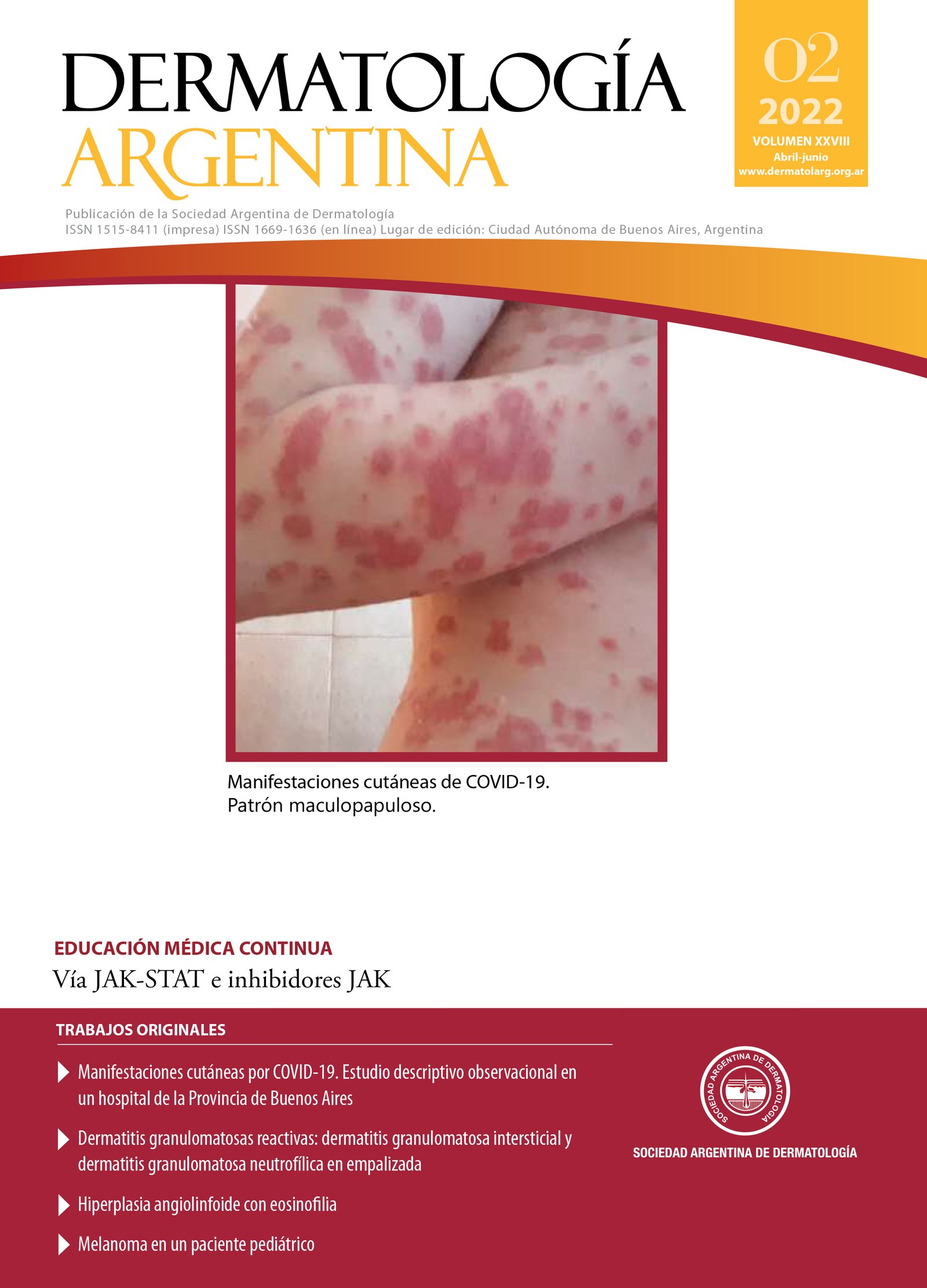Cutaneous manifestations in COVID-19. Observational study in a specialized interzonal hospital in the Province of Buenos Aires
DOI:
https://doi.org/10.47196/da.v28i2.2057Keywords:
Cutaneous manifestations, COVID-19Abstract
Background: since the first description of a viral infection caused by a new coronavirus in Wuhan, China, on December 2019, skin lesions with different patterns have been identified, which have been associated with the severity of the disease.
Objectives: 1) to determine the most frequent types of cutaneous-mucosal patterns; 2) to establish the relationship of skin patterns with the severity of the disease and the time of presentation; 3) to determine if the cutaneous-mucosal pattern could be the only clinical finding of COVID-19 infection. Design: an observational, prospective, longitudinal and analytical study.
Methods: we evaluated the close household contacts of hospitalized patients with a confirmed diagnosis of COVID-19 and the healthcare personnel who suffered from this disease and their close contacts assisted at the Interzonal Specialized Acute and Chronic Hospital (HIEAyC) San Juan de Dios (La Plata, Provincia de Buenos Aires) from June 21st to October 31st 2020.
Results: we found 83 out of 1,145 (7.25%) patients with skin lesions. The patterns found can be depicted as follows: maculopapular in 37 (44.6%), urticarian in 16 (19.3%), perniosis-like in 12 (14.5%), vesicular in 5 (6%) livedoid-necrotic in 4 (4.8%), mixed in 4 (4.8%), and others in 5 (6%). The maculopapular, urticarian and vesicular patterns showed a significant association with the mild forms of the disease. In the simile perniosis pattern, was presented as the only manifestation. The presentation of retiform purpura did not show a significant association with the severity of the disease. 57.8% of the lesions appeared during the appearance of other suspected symptoms of COVID-19, while 25.3% (n = 21) appeared as the only manifestation.
Conclusions: the most relevant data of this study were the finding of mixed patterns scarcely reported in the bibliography and that skin manifestations were the only symptom of SARS-CoV-2 infection in 25.3% of the patients, placing the dermatologist as an indispensable participant in the health team, which diagnoses, monitors and treats these patients. We believe that one of the greatest strengths of our work is the representativeness of the sample size in relation to Latin American publications so far.
References
I. Guan WJ, Ni ZY, Hu Y, Liang WH, et ál. Clinical characte-ristics of coronavirus disease 2019 in China. N Engl J Med. 2020;382:1708-1720.
II. Pandemia de enfermedad por coronavirus de la OMS (COVID-19) [Informes de situación]. Disponible en: https:// www.who.int/emergencies/diseases/novel-coronavirus-2019 [Consultado julio 2020].
III. Reporte de enfermedad por coronavirus en la Argentina (COVID-19). Disponible en: https://www.argentina.gob.ar/coronavirus/informes diarios/reportes/noviembre2020.
IV. Jiang F, Deng L, Zhang L, Cai Y, et ál. Review of the clinical characteristics of coronavirus disease 2019 (COVID-19). J Gen Intern Med. 2020;35:1545-1549.
V. Huang C, Wang Y, Li X, Ren L, et ál. Clinical features of patients infected with 2019 novel coronavirus in Wuhan, China. Lancet. 2020;395:497-506.
VI. Alam M, Lewis W, Harp J, Steele K, et ál. Cutaneous manifestations of COVID-19: characteristics, pathogenesis, and the role of Dermatology in the pandemic. Cutis. 2021:107:209-215.
VII. Gupta A, Madhavan MV, Sehgal K, Nair N, et ál. Extrapulmonary manifestations of COVID-19. Nat Med. 2020;26:1017-1032.
VIII. Galván Casas C, Català A, Carretero Hernández G, Rodríguez-Jiménez P, et ál. Classification of the cutaneous manifestations of COVID-19: a rapid prospective nationwide consensus study in Spain with 375 cases. Br J Dermatol. 2020;183:71-77.
IX. Freeman EE, McMahon DE, Lipoff JB, Rosenbach M, et ál. The spectrum of COVID-19-associated dermatologic manifestations: an international registry of 716 patients from 31 countries. J Am Acad Dermatol. 2020;83:1118-1129.
X. Molero-García JM, Arranz-Izquierdo J, Gutiérrez-Pérez MI, Redondo-Sánchez JM. Aspectos básicos de la COVID-19 para el manejo desde atención primaria. Aten Primaria. 2021;53:101966.
XI. Recalcati S. Cutaneous manifestations in COVID-19: a first perspective. J Eur Acad Dermatol Venereol. 2020;34:212-213.
XII. Verdoni L, Mazza A, Gervasoni A, Martelli L, et ál. An outbreak of severe Kawasaki-like disease at the Italian epicentre of the SARS-CoV-2 epidemic: an observational cohort study. Lancet. 2020; 395:1771-1778.
XIII. Marzano AV, Cassano N, Genovese G, Moltrasio C, et ál. Cutaneous manifestations in patients with COVID-19: a preliminary review of an emerging issue. Br J Dermatol. 2020;183:431-442.
XIV. el-Azhary RA. COVI-19 cutaneous manifestations: simplifying the confusion. Int J Dermatol. 2021;60:3-4.
XV. Ocampo‐Candiani J, Ramos‐Cavazos CJ, Arellano‐Mendoza MI, Arenas‐Guzmán R, et ál. International registry of dermatological manifestations secondary to COVID‐19 infection in 347 Hispanic patients from 25 countries. Int J Dermatol. 2021;60:956-963.
XVI. Visconti A, Bataille V, Rossi N, Kluk J, et ál. Diagnostic value of cutaneous manifestation of SARS‐CoV‐2 infection. Br J Dermatol. 2021:880-887.
Downloads
Published
Issue
Section
License
Copyright (c) 2022 Dermatología Argentina

This work is licensed under a Creative Commons Attribution-NonCommercial-NoDerivatives 4.0 International License.
El/los autor/es tranfieren todos los derechos de autor del manuscrito arriba mencionado a Dermatología Argentina en el caso de que el trabajo sea publicado. El/los autor/es declaran que el artículo es original, que no infringe ningún derecho de propiedad intelectual u otros derechos de terceros, que no se encuentra bajo consideración de otra revista y que no ha sido previamente publicado.
Le solicitamos haga click aquí para imprimir, firmar y enviar por correo postal la transferencia de los derechos de autor











